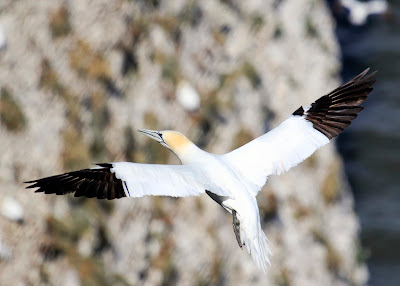There are over 10,000 birds in the world and I want to see and photograph them all. It is the very definition of an impossible task. Too little time and too many birds. I need to post a picture on a daily basis to finish before I am 70. Lets see where we get to...
Saturday, August 3, 2013
267 : Gannet
Gannet - Morus Bassanus
I was chastised by a good friend for my lack of productivity of recent. There is no excuse and I have a heap of new birds to post up after a Summer of travel and more to come.
I'll kick off with a rockstar of a bird. The Gannet or Solan Goose in Scotland or Seth ("arrow") if you were an ancient Celt. Capable of flying thousands of miles over water and coming to land for a few short months each year. Plunge diving onto fish at 60 miles an hour - regulary making forays to collect food to feed their single chick of 300 miles in a day. These are big birds with I think 5 or 6 feet wingspans at full stretch.
I made a trip back to the UK last weekend to break up Summer (and Ramadan) a bit - my wife and kids have returned for the Summer leaving me in Dubai to eat bad food and stay up too late. I rented them a holiday barn/cottage in North Yorkshire and 3 generations of family enjoyed the coast there and particular Bempton RSBP which is the only mainland Gannet colony in England. Stunning.
There are good viewing platforms right opposite the nesting cliffs which are home I think to 20,000 birds during Late April-August. I was actually just up above the birds as they were landing on their nests. Noisy, aggressive birds they cluster together a metre apart building small plinths of seaweed and guano to rest their single eggs.
A constant cycle and rotation of birds landing and heading of to feed.
These birds are restricted to the North Atlantic and Britain and its islands are home to 60 % of the world's population so each breeding site is critical. Gannets first breed when they are 4 or 5 years old spending their initial years in a club next to the colony. For the first year they travel down to West Africa or the Mediterranean for the Winter. Generally the birds all move South during the Winter months but the first year birds go much further South for some reason to learn their fishing trade. Its a tough life for a young Gannet with only 30 % surviving that first year, starvation being the biggest killer.
I have never been so close to these birds before - I have marvelled at them some way offshore before - a distant site in binoculars wheeling and diving or cruising along with barely a wingbeat. They just remind me of the English Summer so much - holidays in Devon or on the Welsh Coast when the boys were much younger.
They are absolutely majestic. Living until 40 years of age they could fly a million miles in a lifetime.
Gannet, Morus Bassanus
Bempton RSPB, Yorkshire
June 28 2013
Subscribe to:
Post Comments (Atom)





No comments:
Post a Comment